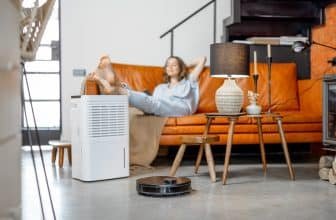Tobacco Smoke Air Purifier: Top Solutions for Clean Indoor Air
Tobacco smoke is a persistent problem for indoor air quality, bringing a host of harmful contaminants into the home. Many people seek solutions to eliminate secondhand and thirdhand smoke from their living spaces. An effective air purifier specifically designed to handle tobacco smoke can significantly improve indoor air quality.
Air purifiers for tobacco smoke are designed with advanced filtration features. True HEPA filters and activated carbon filters work together to trap and neutralize smoke particles and odors. This pairing ensures that even the smallest particles are removed, making your home a healthier place to live.
When choosing an air purifier for tobacco smoke, consider the unit’s coverage area, filter type, and maintenance needs. Quality models are tested and reviewed to ensure they can handle the unique challenges posed by tobacco smoke. Investing in a top-rated air purifier can reduce health risks associated with smoking and protect your family’s well-being.
Key Takeaways: Tobacco Smoke Air Purifier
- Special air purifiers improve indoor air quality by targeting tobacco smoke.
- True HEPA and activated carbon filters are essential for effective smoke removal.
- Choosing the right purifier involves considering coverage area and filter types.
Understanding Air Purifiers and Tobacco Smoke
Air purifiers play a crucial role in removing harmful particles and odors caused by tobacco smoke. Different types of purifiers use various filters and technologies to cleanse the air of contaminants such as PM2.5, PM10, VOCs, and others.
The Impact of Tobacco Smoke on Indoor Air Quality
Tobacco smoke significantly degrades indoor air quality. Cigarette and cigar smoke release fine particles like PM2.5 and PM10 that linger in the air. These particles include tar and other harmful substances.
Additionally, tobacco smoke emits volatile organic compounds (VOCs), which contribute to respiratory problems and unpleasant odors. Secondhand smoke exposure also poses health risks, making clean indoor air essential.
Types of Air Purifiers for Smoke
Several types of air purifiers effectively handle tobacco smoke:
- HEPA Filters: These can trap particles as small as 0.3 microns, including PM2.5 from smoke. They are most effective for particulate matter.
- Activated Carbon Filters: These filters adsorb VOCs and odors through a process known as adsorption, effectively reducing harmful gases.
- Mechanical Filtration: This method involves physical barriers to capture larger particles.
- Hybrid Systems: Some air purifiers combine HEPA and carbon filters for comprehensive smoke removal.
Each type of filter has its benefits, making it important to choose one that best fits the needs of removing tobacco smoke.
How Air Purifiers Address Tobacco Contaminants
Air purifiers combat tobacco contaminants through several mechanisms. HEPA filters capture fine particulate matter like PM2.5 and PM10, which are common in smoke. These mechanical filters physically trap smoke particles, preventing them from circulating.
Activated carbon filters are effective for absorbing VOCs and odors. This filtration targets gaseous pollutants, rendering the air fresher and safer.
Some advanced models also offer pre-filters which capture larger particles, thus extending the lifespan of HEPA and carbon filters. These combined technologies ensure a thorough purification process, resulting in cleaner and healthier indoor air.
For those dealing with frequent exposure to tobacco smoke, investing in a high-quality air purifier is a vital step towards maintaining healthier indoor air quality.
Key Features of Air Purifiers for Smoke
When choosing an air purifier for smoke, it’s crucial to consider specific features like advanced filtration methods, the Clean Air Delivery Rate (CADR), and additional features that enhance air quality. Each of these elements plays a significant role in the purifier’s effectiveness.
HEPA and Activated Carbon Filtration
Air purifiers designed for smoke often include HEPA and activated carbon filters. HEPA filters are important because they can capture tiny particles, including those found in cigarette smoke. They are highly effective in removing up to 99.97% of airborne particles as small as 0.3 microns.
Activated carbon filters are crucial for eliminating odors and volatile organic compounds (VOCs) from tobacco smoke. They work by absorbing these compounds, which helps in significantly reducing the smell and harmful constituents of smoke. Some air purifiers might even use a three-stage filtration system that combines HEPA and activated carbon filters with an additional pre-filter for maximum efficiency.
CADR Ratings and Their Importance
The Clean Air Delivery Rate (CADR) is a metric that measures the volume of air an air purifier can clean in a certain period. When buying an air purifier for smoke, it’s essential to check the CADR rating for smoke. Higher CADR ratings indicate better performance in removing smoke particles from the air.
For example, air purifiers with a CADR rating above 200 for smoke can clean the air in an average-sized room quickly and effectively. This rating helps consumers understand the purifier’s efficiency and choose one that matches their room size and specific needs for handling smoke.
Additional Features for Improved Air Quality
Modern air purifiers come with several additional features to enhance their performance. Auto mode and smart features allow the purifier to adjust its settings based on real-time air quality measurements. This ensures optimal operation without needing manual adjustments.
Some purifiers include an ionizer to release negative ions, which help in clumping smaller particles together, making them easier to filter out. Customizable filters allow users to select specific filters that address their unique air quality concerns, possibly improving the removal of particular smoke-related pollutants. These features together make a significant difference in maintaining cleaner and healthier indoor air.
Considerations for Choosing an Air Purifier
When choosing an air purifier, it’s important to consider factors such as the size of the room it will be used in, the design and noise level of the unit, and its maintenance requirements, including filter replacements.
Room Size and Coverage Area
Knowing the size of the room is key in selecting the right air purifier. Most models come with a specified coverage area, often measured in square feet. For example, the Levoit Core 600S is suitable for larger rooms, while the Levoit Core 300 is designed for smaller spaces.
Check the Clean Air Delivery Rate (CADR) for smoke, measured in cubic feet per minute (CFM). Higher CADR means more effective smoke removal. A model with a smoke CADR of 300 or more is ideal for larger spaces. Also, consider multiple fan speeds to adjust based on room needs and airflow efficiency.
Design and Noise Level
The design of an air purifier impacts both aesthetics and functionality. Sleek models like the Blue Pure 311i+ Max blend well with home decor. Compact units are better for small spaces, while larger models offer more power for bigger rooms.
Noise level, measured in decibels, is crucial for comfort. Air purifiers can range from whisper-quiet at low speeds to more noticeable at high speeds. Look for models with a noise level under 50 decibels for nighttime use. Some units also have “sleep mode” features to reduce noise without sacrificing performance.
Maintenance and Filter Replacement
Regular maintenance ensures an air purifier operates efficiently. Most purifiers use multiple filters, including HEPA and charcoal filters, to trap particles and odors. Some models, like the Coway Airmega, have washable pre-filters to extend the life of the main filters.
Filter replacement intervals vary; typically, HEPA filters last around 6-12 months, while activated carbon filters may need replacement every 3-6 months. Ensure the purifier has indicator lights or alerts to signal when it’s time to change filters. Check for easy-to-access filters to simplify the replacement process.
Health Benefits and Effectiveness
Air purifiers are often praised for their ability to reduce indoor air pollution, particularly in homes with smokers. This section will discuss how air purifiers help decrease health risks and evaluate their effectiveness against smoke.
Reducing Health Risks Associated with Tobacco Smoke
Tobacco smoke can negatively impact health, triggering asthma and allergies. It introduces harmful particulate matter into the air, including chemicals like nicotine and tar, leading to respiratory symptoms.
Air purifiers can significantly help by filtering out these particles. Reducing pollutants can lower risks of smoke-related health issues such as coughing, wheezing, and even more severe conditions like lung disease. Improved indoor air quality may alleviate symptoms for those with pre-existing conditions.
Assessing the Effectiveness of Air Purifiers against Smoke
Air purifiers work through filtration systems that capture fine smoke particles. They can be quite effective in removing odor and particulate matter from the air. For example, technologies like HEPA filters can capture small particles, improving air quality.
However, their effectiveness varies by type and brand. According to research, some models significantly reduce particulate levels. Despite this, not all devices are equally efficient. The Environmental Protection Agency (EPA) notes that while purifiers can help, they are not a complete solution for eliminating all indoor smoke pollutants.
Top Rated Air Purifiers for Tobacco Smoke
Selecting the right air purifier can make all the difference in keeping indoor air fresh and free of tobacco smoke. Premium options offer advanced features for high efficiency, while budget-friendly models balance cost with functionality.
Premium Options: High Efficiency and Advanced Features
High-end air purifiers are powerful and feature-rich. The Rabbit Air MinusA2 Ultra Quiet stands out with its six-stage filtration system, including a True HEPA filter and active carbon filter. This ensures maximum removal of smoke particles and odors.
The IQAir HealthPro Plus is another top choice. It features HyperHEPA filtration, which captures ultrafine particles that are much smaller than traditional HEPA standards. This unit is ideal for large spaces, as it can clean the air in rooms up to 1,125 square feet.
Both of these models are recognized by the Association of Home Appliance Manufacturers (AHAM) for their effectiveness against smoke. These air purifiers offer advanced features like Wi-Fi connectivity and customizable filters, making them suitable for individuals who need top-tier performance and convenience.
Budget-Friendly Air Purifiers: What to Expect
Affordable air purifiers provide basic yet effective smoke filtration. The Levoit Core 300 Air Purifier is a popular budget option. It comes with a True HEPA filter and is great for smaller areas, making it suitable for bedrooms or office spaces.
Another cost-effective option is the Blueair Blue Pure 211i Max. Priced between $300 and $900, it offers powerful smoke removal capabilities. It is designed for larger spaces around 500 square feet, ensuring effective air purification even in bigger rooms.
These budget-friendly models might lack some advanced features found in premium options, such as smart home integration or custom filter options. However, they still provide robust smoke filtration, making them a practical choice for cost-conscious consumers.
Frequently Asked Questions
When choosing an air purifier for tobacco smoke, it’s essential to consider specific features and types. Here’s what you need to know about the effectiveness, performance, and recommendations for dealing with tobacco smoke.
What features should I look for in an air purifier to remove tobacco smoke effectively?
Look for an air purifier with a HEPA filter, which captures tiny particles. An activated carbon filter is also vital as it helps remove odors and harmful gases. Consider air purifiers with high CADR (Clean Air Delivery Rate) specifically rated for smoke.
How do HEPA air purifiers perform against tobacco smoke particles?
HEPA air purifiers are effective at trapping smoke particles. These purifiers capture particles as small as 0.3 microns, including tobacco smoke. While they don’t eliminate gases or odors, pairing a HEPA filter with an activated carbon filter can provide comprehensive smoke removal.
Can air purifiers completely eliminate the odor of cigarette smoke in a room?
Air purifiers with activated carbon filters can reduce but not entirely eliminate cigarette smoke odors. Activated carbon absorbs many of the volatile organic compounds (VOCs) responsible for smells. However, persistent smoke odors may require additional cleaning and ventilation.
Are there any special types of air purifiers recommended by Consumer Reports for cigarette smoke?
Consumer Reports often recommend air purifiers like the Blue Pure 311i+ Max for their effectiveness in removing smoke due to advanced filtration systems. They focus on models that feature both HEPA and activated carbon filters for maximum efficiency.
What are the top-rated air purifiers for tobacco smoke as reviewed by users?
Users highly rate air purifiers such as the Levoit Core 600S Smart Air Purifier and the Winix 5500-2. These models are praised for their performance in smoke removal and ease of use. Check reviews for real-world feedback on the effectiveness and maintenance.
How can I effectively filter out cigarette smoke from my home environment?
To effectively filter out cigarette smoke, use an air purifier with both HEPA and activated carbon filters. Position the purifier where smoke is most prevalent, and ensure regular maintenance of filters. Incorporating other measures like increasing ventilation and avoiding indoor smoking can greatly help.
best air purifiers
My name is Philipp Walz, editor at best-air-purifiers.com, and I’m truly passionate about creating healthier living spaces through smart, effective air purification. For me, air purifiers aren’t just appliances – they’re a quiet revolution in how we breathe, live, and feel at home. Clean air means better sleep, clearer thinking, and fewer allergies. It’s about giving our bodies what they need most: pure, fresh air. I’ve experienced firsthand how the right air purifier can transform a space and improve well-being – and I’m here to help others discover that difference. Because when you breathe better, you live better.






